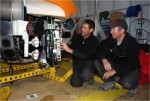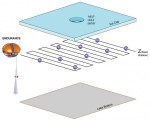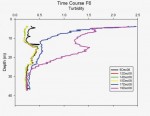Members of the McMurdo (MCM) LTER researching perennially ice covered lakes are thrilled by access to a new tool which is revolutionizing our view of one of the lakes, West Lake Bonney (WLB). The Environmentally Non-Disturbing Under-ice Robotic ANtarctic Explorer (ENDURANCE) is an autonomous underwater vehicle capable of generating for the first time 3-D biogeochemical whole-lake datasets.
The ENDURANCE robot is equipped to measure a comprehensive suite of physical and biogeochemical indices in the water column. These parameters include temperature, conductivity, pH levels, redox, chlorophyll-a, turbidity, dissolved organic matter, and photosynthetically active radiation, as well as imagery of the lake bottom and the underside of the ice. It collects these data by swimming just under the ice cover and lowering its science package through the water column along a 100 m x100 m horizontal grid (Figure 1). Sonar mapping of the bathymetry and lake ice thickness and imaging of the underwater glacier face of Taylor Glacier is also part of the suite of measurements. All of these efforts go toward testing our two main hypotheses:
- The low kinetic energy of the system (diffusion dominates the spatial transport of constituents) produces an ecosystem and ecosystem limits that vary significantly in three dimensions.
- The whole-lake physical and biogeochemical structure remains static from year to year.
ENDURANCE has already completed one field season in the dry valleys, mapping out about 2/3 of WLB, and first-pass mapping and imaging the face of Taylor Glacier. In our first field season, imaging the glacier face was hindered by poor visibility once the streams started flowing. The changing conditions also impacted our spatial biogeochemical mapping. To overcome this in year two we will arrive earlier in the field season and finish before any significant melt occurs. During the first season we also made repeated measurements at a node point near the base. The change in turbidity over the season is clearly seen in the data (Figure 2).
ENDURANCE was designed and built by Stone Aerospace of Austin, Texas. The National Aeronautics and Space Administration (NASA) funded the design, construction, and science of ENDURANCE, while the National Science Foundation's Office of Polar Programs has provided considerable logistical support in Antarctica. Two MCM LTER Principal Investigators, Peter Doran and John Priscu (Figure 3), are responsible for ENDURANCE science, and for making sure that the data collected are compatible and conform to LTER standards. Data analysis and synthesis is being aided by software tools developed by UIC's Electronic
Visualization Lab. Ideally we would like to have ENDURANCE work in other MCM lakes in the future, but our current funding is only for WLB.
A second field season began in October 2009 and we will be operational at WLB until the first week of December. Doran and Priscu, along with other MCM LTER lakes personnel, will work closely with the 2009 ENDURANCE team of seven engineers from Stone Aerospace and an undergraduate from University of Illinois at Chicago, in addition to carrying out their regular MCM research.
Peter Doran is with the Earth and Environmental Sciences department at the University of Illinois at Chicago, Chicago, IL

 Enlarge this image
Enlarge this image

